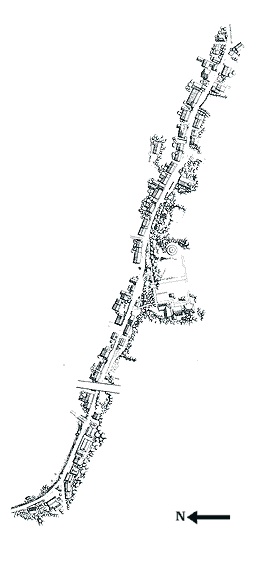|
|
In March of 1997 the City Government of Kyoto has revised and reformulated its entire preservation strategies in which - with its own words - ‘conservation, renaissance and creation can coexist in harmony’. This brought about a certain renaming of individual preservation districts.
|
|
|
Urban preservation is now divided into five categories:
Preservation of Townscapes,
Preservation of Historic Urban Landscapes,
Preservation of Green Spaces,
Preservation of Scenic
Landscapes and preservation of Natural Scenery.
|
|
Sanneizaka district
|
Preservation of Historic Townscapes
- Aesthetic Areas, (bikan chiku) now measuring
1,804 hectares and occupying mostly the central
and eastern parts of Kyoto, are characterized by
‘tasteful townscapes and groups of multistoried buil
-dings that form anaesthetically pleasing complex.’These
areas are further classified into five categories according
to their aesthetic and historic quality. New constructions or
|
 |
| alteration in those areas need the prior consent of the city planning |
department. Different building standards, such as height limits, roof-form, and grouping are laid down in detail for each of the five categories.
- Townscape Adjustment Areas (kenzōbutsu shukei chiku) now comprizing 6,873 hectares of urban land, cover more or less the rest of Kyoto’s built-up inner city area. Admittedly, this vast area is less severly regulated than the Aesthetic Areas, but nevertheless it is further subdivided into two categories according to the degree the surrounding mountains have a visual impact on the area. Therefore, the two areas have different height restrictions ranging from 12 to 31 meters. The Townscape Adjustment Area also comprizes the central square area between Gojo and Oike, and Horikawa and Kawaramachi respectively, for which 45 meters were recently set as general height-limit for buildings facing these streets directly. In exceptional cases, however, such as the new Kyoto Hotel, construction up to a final limit of 60 m can be allowed, if the owner donates a part of his site for public amenities. In other words, the area lost can thus be put on top of his building, the height of which must never exceed 60 meters.
- Roadside Landscape Formation Area (endō keikan keisei chiku) is concerned with particular care of design being given along both sides of major city streets, such Oike Dori for instance.
- Historic Atmosphere Preservation Area (kaiwai keikan seibi chiku) is a specially treated area within the Aesthetic Areas or Townscape Adjustment Areas because of the unique design qualities of a set of buildings and the sense of unity pervading them. So far three such areas have been designated within Kyoto, of which the Sanjo Area with six hectares has been mentioned before; the other two are the Kamigamo-go area of 22 hectares and the Fushimi Minami-hama area of 25 hectares. |
|
| Right: Gion Shimbashi district |
|
| Below: Sagano Torri Moto district |
|
 |
|
|
- Preservation Areas for Groups of Historic Buildings (dentō-teki kenzōbutsugun hozon chiku ) amount to 14.9 hectares in Kyoto as of March 1997.
Sanneizakaarea with 8.2 hectares, is the largest of the four designated in Kyoto so far. It was originally designated in 1976, and amended in December 1995. See detailed description below.
Gion Shimbashiwas designated in 1976, too. It is situated in the downtown Gion Quarters, a high-class entertainment spot with traditional Kyoto O-chaya, or teahouses frequented also by Geishas. It comprizes about 1.4 hectares with approximately 80 traditional Kyoto townhouses, 56 of which are designated as ‘important’.
Sagano Torii Moto was designated 1979. It is situated at the foot of the north-western mountains of Kyoto and has very much grown as a ‘town in front of the gates’ of Atago Shrines. This rustic linear village presents a beautiful mixture of farm- houses, townhouses, and teahouses and restaurants. It covers about 2.6 hectares with 55 houses, 28 of which are designated as important.
|
|
|
|
|
| Kamigamo area of Shinto Priests’ Residences was designated in 1988. It measures 2.7 hectares to the south Kamigamo Shrine, one of the tutelary shrines of the Heian Court and ancient Kyoto. The luxurious gardens of the mostly one-storied residences are fed by a small river coming from the mountains, running through the shrine precinct and then along one side of the main street. |
|
|
Preservation of Historic Landscapes
|
Preservation Districts of Historical Landscapes
(rekishiteki fūdo no hozen chiku) were created as
a separate category in 1966 and have by now been
extended to 14 districts of 8,513 hectares, and those
designated as ‘special’ amongst them to 24 districts
of 2,861 hectares. New constructions of anykind are
|
|
as a rule not permitted within those districts.
Preservation of Green Spaces
|
Suburban Green Protection Areas (ryokuchi hozenchiku)
were initiated already in 1969 and constantlyfurther expan
ded as amenities for Kyoto’s residents.They comprize now
|
|
in its three sub-groups approximately 3,570 hectares.
|
|
|
|
Preservation of Scenic Landscapes
|
Scenic Open Spaces (fūchi chiku) the first category of
Space-preservation enacted in 1930, has ever been ex-
-panded and has now reached 17,831 hectares comprizing
17 distinct districts. These Scenic Landscapes have been re-
-classified in 1966 into five categories according to their degree of
beauty. Preservation standards and building codes vary in the respec- |
|
|
|
|
-tive five categories.
Preservation of Natural Scenery
By a City Ordinance in March 1995 Preservation Areas for Natural Scenery (shizen fūkei hozen chiku) were established; their goal was to preserve the natural scenery of the natural mountain ranges in their natural form and original scenery. There are two categories of it which differ in the degree amount of human construction and activity allowed in them. They now comprize 25,780 hectares and to a large degree coincide with the Scenic Landscape Areas.
|
|
